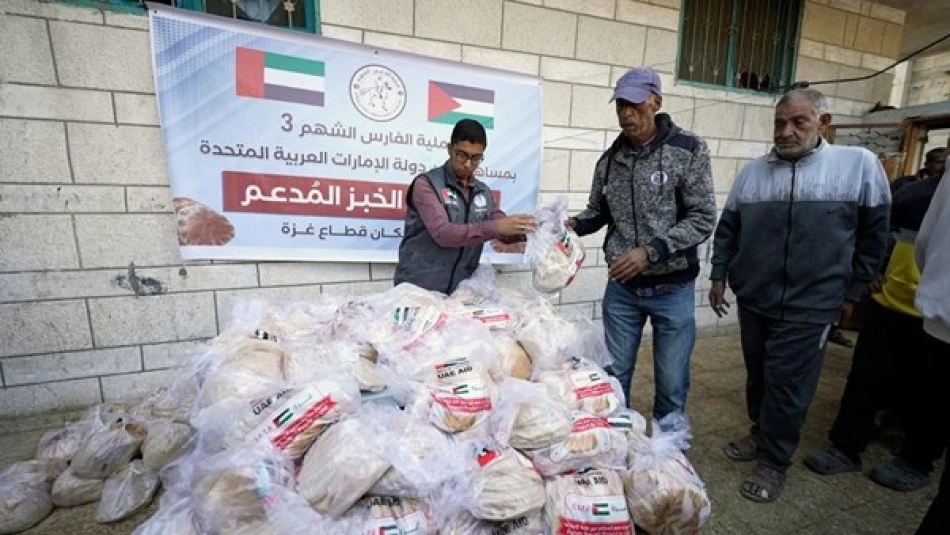
UAE Brings Hope to Gaza, Breaks Food and Water Blockade Impacting Residents
UAE Emerges as Gaza's Lifeline: Providing 44% of All International Aid Amid Catastrophic Humanitarian Crisis
As Gaza faces its worst humanitarian catastrophe in decades, with 147 people—including 88 children—dying from malnutrition and over 500,000 residents experiencing famine-like conditions, the United Arab Emirates has positioned itself as the strip's primary lifeline. UN reports confirm that UAE aid now represents 44% of all international assistance reaching Gaza, a remarkable concentration of relief efforts that underscores both the severity of the crisis and the Gulf nation's strategic humanitarian diplomacy.
The Scale of Gaza's Humanitarian Catastrophe
Recent data from the World Food Programme and UNICEF paint a devastating picture: 39% of Gaza's population goes days without food, while nearly a quarter of the territory's 2.3 million residents face famine-like conditions. The remaining population confronts emergency-level hunger, creating what aid organizations describe as one of the most acute humanitarian crises of the modern era.
The situation has deteriorated rapidly since the conflict began approximately 18 months ago, with over 80% of water infrastructure destroyed and bread production—a dietary staple—severely compromised. Medical sources report that malnutrition-related deaths continue climbing, with children bearing the heaviest burden.
UAE's Multi-Pronged Relief Strategy
Innovative Food Distribution Networks
The UAE has deployed an unprecedented multi-modal approach to food delivery, utilizing land, air, and sea routes to circumvent logistical challenges. The "Birds of Goodness" airdrop operations have become a signature element of the relief effort, while maritime deliveries—including the recent Khalifa ship carrying 7,166 tons of supplies—demonstrate the scale of the operation.
More strategically, the UAE has focused on sustainable food production rather than just distribution. In February 2024, automatic bakeries were shipped into Gaza, supported by flour supplies and technical assistance to operate over 21 field bakeries. This approach addresses the root cause of bread shortages rather than merely treating symptoms.
Water Infrastructure: A Long-term Investment
Perhaps most significantly, the UAE has tackled Gaza's water crisis through infrastructure development. Six desalination plants now produce two million gallons daily, serving over 600,000 residents. The crown jewel is a new 6.7-kilometer water pipeline connecting UAE-built desalination facilities in Egypt to displacement areas between Khan Younis and Rafah.
This $15-per-person daily water allocation represents a massive logistical undertaking, requiring cross-border coordination and substantial technical expertise. The project's scope—serving 600,000 people through a single pipeline—rivals major municipal water systems in developed countries.
Strategic Implications for Regional Diplomacy
The UAE's dominant role in Gaza relief reflects broader shifts in Middle Eastern geopolitics. Unlike traditional aid approaches focused on temporary relief, the Emirates has invested in infrastructure that could outlast the current crisis. This mirrors the UAE's development model in other regional interventions, from Yemen to Sudan, where long-term capacity building takes precedence over short-term assistance.
The 44% aid concentration also highlights the relative absence of other major donors. While European and American governments provide funding to UN agencies, the UAE's direct operational involvement suggests a more hands-on approach to humanitarian diplomacy.
Operational Challenges and Innovations
The UAE's success in delivering aid stems partly from its willingness to work across multiple channels simultaneously. During Ramadan alone, Emirati organizations distributed 13 million iftar meals through 44 charitable kitchens, while maintaining 17 bakeries serving over 3.1 million people.
This operational flexibility—combining traditional charity models with industrial-scale food production—represents an evolution in humanitarian response. Rather than relying solely on international agencies, the UAE has created parallel distribution networks that can adapt quickly to changing conditions.
Economic and Political Calculations
The UAE's Gaza commitment carries significant costs but offers substantial returns in regional influence and international standing. By positioning itself as Gaza's primary benefactor, the Emirates strengthens relationships with both Palestinian leadership and Arab public opinion, while demonstrating humanitarian leadership to Western partners.
The infrastructure investments, particularly in water systems, also create long-term dependencies that could influence post-conflict reconstruction planning. Countries that control essential services often shape political outcomes, a lesson the UAE has applied in other regional contexts.
Sustainability Questions
While the UAE's intervention has undoubtedly prevented a more severe humanitarian catastrophe, questions remain about long-term sustainability. The current aid model requires continuous funding and complex logistics that few countries could maintain indefinitely.
However, the focus on infrastructure development—desalination plants, bakeries, water pipelines—suggests the UAE is building systems designed to function beyond the immediate crisis. This approach could provide a template for humanitarian intervention in other protracted conflicts, where traditional aid models have proven insufficient.
The UAE's Gaza operation represents more than emergency relief; it demonstrates how middle powers can leverage humanitarian crises to enhance regional influence while addressing genuine human suffering. As the situation continues evolving, the Emirates' 44% aid share positions it as an indispensable player in any future reconstruction efforts.
 Layla Al Mansoori
Layla Al Mansoori







